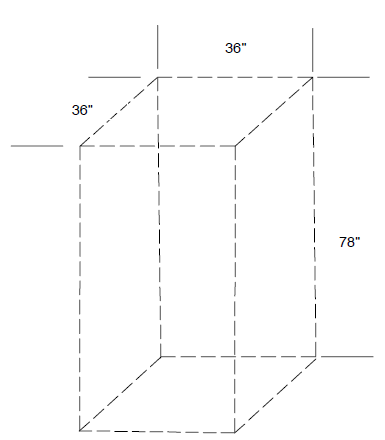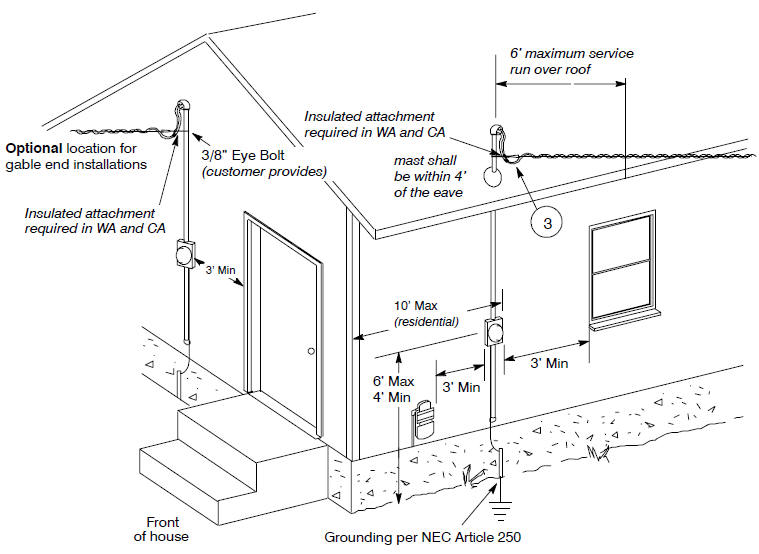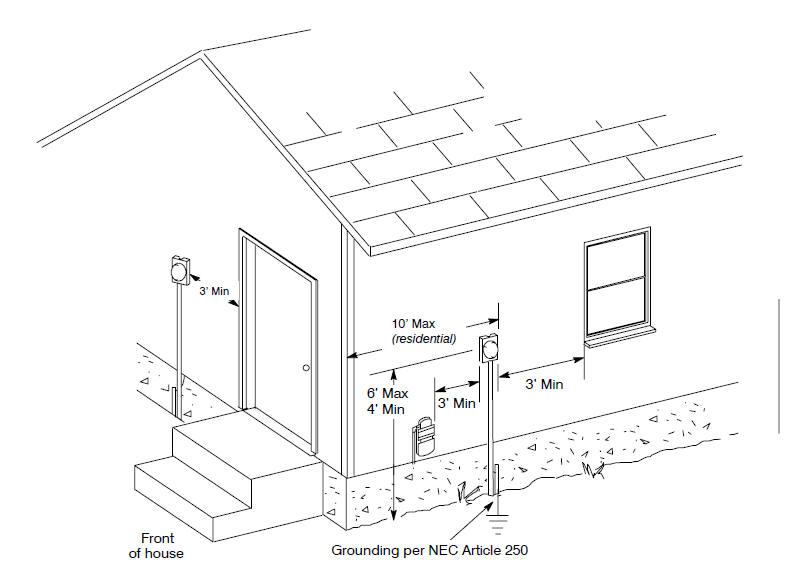What does an Electrical Service Look Like?
There are four wires involved with supplying the main panel with power. Three of them will come from the utility company, and a fourth (bare) wire comes from elsewhere.
The bare wire is connected to one or more long metal bars pounded into the ground, or to a wire/rebar buried in the foundation (a.k.a. ufer ground), or sometimes to the water supply pipe (has to be metal, continuous to where the main water pipe entering the house. Watch out for galvanic action conductivity "breaks" (often between copper and iron pipe). This is the "grounding conductor". It is there to make sure that the third prong on your outlets is connected to ground. This wire normally carries no current.
One of the other wires will be white (or black with white or yellow stripes, or sometimes simply black). It is the neutral wire. It is connected to the "center tap" of the distribution transformer supplying the power. It is connected to the grounding conductor in only one place (usually inside the main panel). The neutral and ground should not be connected anywhere else. Otherwise, weird and/or dangerous things may happen.
Furthermore, there should only be one grounding system in a home. Some codes require more than one grounding electrode. These will be connected together, or connected to the neutral at a common point - still one grounding system. Adding additional grounding electrodes connected to other portions of the house wiring is unsafe and contrary to code.
If you add a subpanel, the ground and neutral are usually brought as separate conductors from the main panel, and are not connected together in the subpanel (ie: still only one neutral-ground connection). However, in some situations (certain categories of separate buildings) you actually do have to provide a second grounding electrode - consult your inspector.
The other two wires will usually be black, and are the "hot" wires. They are attached to the distribution transformer from your utility company as well. The two black wires are 180 degrees out of phase with each other. This means if you connect something to both hot wires, the voltage will be 220 volts. If you connect something to the white and either of the two blacks you will get 110V. Some panels seem to only have three wires coming into them. This is either because the neutral and ground are connected together at a different point (eg: the meter or pole) and one wire is doing dual-duty as both neutral and ground, or in some rare occasions, the service has only one hot wire (110V only service).
Service Entrance Ground Size Requirements
Reference NEC 2008, Table 250-66
| Size of Largest Ungrounded Service-Entrance Conductor or Equivalent Area for Parallel Conductors (AWG/kcmil) | Size of Grounding Electrode Conductor (AWG/kcmil) | ||
| Copper | Aluminum or Copper-Clad Aluminum | Copper | Aluminum or Copper-Clad Aluminum |
| 2 or smaller | 1/0 or smaller | 8 | 6 |
| 1 or 1/0 | 2/0 or 3/0 | 6 | 4 |
| 2/0 or 3/0 | 4/0 or 250 | 4 | 2 |
| Over 3/0 through 350 | Over 250 through 500 | 2 | 1/0 |
| Over 350 through 600 | Over 500 through 900 | 1/0 | 3/0 |
| Over 600 through 1100 | Over 900 through 1750 | 2/0 | 4/0 |
| Over 1100 | Over 1750 | 3/0 | 250 |
Power Meter - Required Working Space in Front of Meter
Part of installing a new electrical service is mounting a main power panel or power meter. We used a combination panel that had both. Utility companies will typically require a working space in front of your power meter similar to what is shown below. This allows service technicians or electricians to comfortably and safely work with your power meter and main service panel.

Power Meter - Clearances for Building Supporting an Overhead Service
The diagram below shows your power meter is required to be 3' minimum from an entrance door, gas meter, or window opening. The meter should also be located within 10ft of the front corner of a residence. These requirements are set by your utility company, in our case Pacific Power. This is pretty typical for installing new electrical services in other parts of the country as well.

Power Meter - Clearances for Underground Service

How to Install a Service Entrance
Pratique
-
This video covers how to install a service entrance on your home. Also covered is how your homes electric feed is interfaced with the lines on the power poles in front of your home.
Safety and Health
Cut, Screw and Joint
-
Using screw drivers
Solder Wires
Build wire joints : BritanniaBuild wire joints : Western union JointsBuild wire joints : TBuild wire joints : straight
Soldering, Brazing and basic measures
Advanced Measurements
-
Verification of Ohm's law
Verification of Kirchoff's laws
Verification of laws of series, parallel and combination circuits
Verification of open circuit and closed circuit networkMeasuring unknow resistance using Wheatston Bridge Measuring unknow resistance by voltage drop method
Advanced Electric Tools
Residential Workplace Safety
-
Understanding the Shock HazardPersonal Protective EquipmentGround Rules for General and Electrical Safety Classes of Fires and Types of ExtinguishersProcedures
Hardware and Materials Used in Residential Wiring
-
Electrical BoxesConductors and Cable TypesRacewaysDevicesOvercurrent Protection DevicesPanelboards, Loadcenters, and Safety SwitchesFasteners
Understanding Residential Building Plans
-
Glossary of TermsOverview of Residential Building PlansCommon Architectural SymbolsElectrical SymbolsResidential Framing Basics
